Videos and fly-throughs from the 2006 Mariana Arc expedition
2006 Videos:
The edited video clips show highlights from dives with the JASON II remotely operated vehicle on submarine volcanoes in the Mariana Arc. These movies are larger format versions (480 x 360) of the video clips available on the NOAA Ocean Exploration web site, along with images and logs from the expedition.
Sites/Subjects:
NW Rota 1: Brimstone Pit (eruption) | Animals (shrimp, dead
animal rain)
Daikoku: Sulfur lake | flatfish
Nikko: Sulfur pools
East Diamante: Chimneys
|tropical life
Eifuku: Mussels | liquid CO2
Seamount X: Squat lobsters
Forecast: Snails | shrimp
Videos | ||
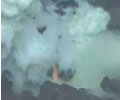 Glowing red eruption. Quicktime 26.5 MB Windows Media: 8.2 MB |
||
Brimstone Pit EruptionThis is the first time that glowing lava has ever been witnessed from a submarine volcanic eruption! In this case, the lava is rising in the vent so fast that a small glimpse of red glow can be seen intermittently before it crusts over or is blown apart. What a sight! Do you think the scientists were a little excited? |
||
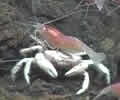 Shrimp hitching a crab for a ride. Shrimp hitching a crab for a ride.Quicktime: 18.5 MB Windows Media: 6.8 MB |
Crab RideOne of the carnivorous shrimp resident at NW Rota-1 volcano catches a ride on a crab that is passing by.
|
|
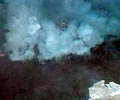 Molten
sulfur lake. Molten
sulfur lake.Quicktime: 18.4 MB Windows Media: 7.0 MB |
||
Sulfur LakeMolten sulfur and volcanic gases are bubbling out of a vent along the far wall of Sulfur Cauldron and keep the partially crusted surface of the pond undulating. Sometimes the heaving is so great that pieces of crust near the vent break off, tip on end, and are pulled downward by the convecting currents in the pond. |
||
 Flatfish
at Daikoku. Flatfish
at Daikoku.Quicktime: 17.6 MB Windows Media: 7.0 MB |
FlatfishA dense group of tonguefish on the sedimented seafloor at Daikoku. The fish are more active than they appear at first glance.
|
|
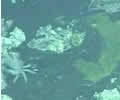 Sulfur
pools . Sulfur
pools .Quicktime: 21.2 MB Windows Media: 8.1 MB |
||
Sulfur PoolsWhen Jason tries to sample a rock, it sinks through the thin crust on the lake of molten sulfur and a crab barely survives the experience! At the end of the dive we found that part of the Jason frame had also broken through this crust and was coated in sulfur. |
||
 Tropical
life at shallow seamount. Tropical
life at shallow seamount.Quicktime: 21.4 MB Windows Media: 8.1 MB |
||
Tropical LifeA multitude of tropical life exists at the shallow Aquarium site.
|
||
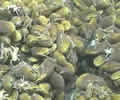 Mussels
and shrimp. Mussels
and shrimp.Quicktime: 16.9 MB Windows Media: 6.5 MB |
||
MusselsIn addition to the dense colonies of mussels at NW Eifuku, there are also the same two species of shrimp that we found at NW Rota-1 (the volcano we found to be actively erupting). However, at NW Eifuku the two shrimp species live in different habitats separated from one another, whereas at NW Rota-1 they are found. |
||
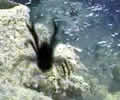 Flying
squat lobsters. Flying
squat lobsters.Quicktime: 20.6 MB Windows Media: 8.2 MB |
||
Flying Squat LobstersSquat lobsters (galatheids) in "flight" at Seamount X. |
||
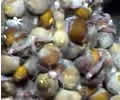 Snails,
crabs,and shrimp. Snails,
crabs,and shrimp.Quicktime: 21.2 MB Windows Media: 8.1 MB |
||
Snails and shrimpIntensely shimmering water vents from the seafloor atop Forecast seamount. The temperature probe on Jason II measured temperatures as high as 200 degrees C at nearby vents. Snails and shrimp have colonized the site and a grazing on chemosynthetic bacteria. Jason's suction sampler is used to collect some of these animals for analysis in the lab on board the ship. |
||

